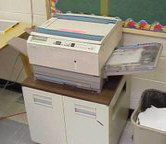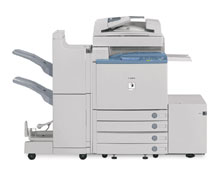Photocopying
From Wikipedia, the free encyclopedia
 Photocopying is a process which makes paper copies of documents and other visual images quickly and cheaply. It was introduced by Xerox in the 1960s, and over the following 20 years it gradually replaced copies made by carbon paper, mimeograph machines and other duplicating machines. The prevalence of its use is one of the factors that prevented the development of the paperless office heralded early in the digital revolution.
Photocopying is a process which makes paper copies of documents and other visual images quickly and cheaply. It was introduced by Xerox in the 1960s, and over the following 20 years it gradually replaced copies made by carbon paper, mimeograph machines and other duplicating machines. The prevalence of its use is one of the factors that prevented the development of the paperless office heralded early in the digital revolution.
Photocopying is widely used in business, education, and government. There have been many predictions that photocopiers will eventually become moot as information workers continue to increase their digital document creation and distribution, and rely less on distributing actual pieces of paper. However, photocopiers are undeniably more convenient than computers for the very common task of creating a copy of a humble piece of paper.
Contents[hide] |
How a photocopier works
- First, the surface of a drum is given an electro-static charge by a high-voltage wire called a corona wire. The drum is coated with a semiconductor material, such as selenium or germanium.
- Then light is beamed in thin strips onto the image. Only the white areas of the picture reflect this light. The light then hits the drum, which is specially conditioned to make it photoconductive. This means that when light hits it, it neutralizes the positive charges.
- As a result, the white areas of the picture are now neutral, and the black areas are positive.
- The toner is negatively charged. When it is applied to the drum, it sticks to the areas that are positively charged, just like paper sticks to a charged balloon.
- The toner is then attracted onto a positively charged piece of paper.
- The toner is a dry ink substance. If paper came out of the photocopier covered in dry toner it would just brush off, so the toner is heated to make it melt and to bind it to the paper.
Invention
In 1937 Bulgarian physicist Georgi Nadjakov discovered the photoelectric effect. He found that when placed into electric field and exposed to light, some dielectrics acquire permanent electric polarization at the exposed areas. That polarization persists, in the dark and is destroyed in light. Chester Carlson, the inventor of photocopying, was originally a patent attorney and part time researcher and inventor. His job at the patent office in New York required him to make a large number of copies of important papers. Carlson, who was arthritic, found this a painful and tedious process. This prompted him to conduct experiments in the area of photoconductivity, through which multiple copies could be made with minimal effort. Carlson experimented with "electrophotography" in his kitchen and in 1938, applied for a patent for the process. He made the first "photocopy" using a zinc plate covered with sulfur. The words "10-22-38 Astoria" were written on a microscope slide, which was placed on top of more sulfur and under a bright light. After the slide was removed, a mirror image of the words remained. Carlson tried to sell his invention to some companies, but because the process was still underdeveloped he failed. At the time multiple copies were made using carbon paper or duplicating machines, and people did not feel any dire need for an electronic machine. Between 1939 and 1944, Carlson was turned down by over 20 companies, including IBM and GE, neither of which believed there was a significant market for copiers.
In 1944, the Battelle Memorial Institute, a non-profit organization in Columbus, Ohio, contracted with Carlson to refine his new process. Over the next five years, the institute conducted experiments to improve the process of electrophotography. In 1947 Haloid (a small New York based organisation manufacturing and selling photographic paper at that time) approached Battelle to obtain a license to develop and market a copying machine based on this technology.
Haloid felt that the word "electrophotography" was too complicated and did not have good recall value. After consulting a professor of classical language at Ohio State University, Haloid and Carlson changed the name of the process to "Xerography", derived from Greek words which meant "dry writing". Haloid decided to call the new copier machines "Xerox" and in 1948, the word Xerox was trademarked.
In the early 1950s, RCA (Radio Corporation of America) introduced a variation on the process called Electrofax where images are formed directly on specially coated paper and rendered with a toner dispersed in a liquid.
use
In 1949, the Xerox introduced the first xerographic copier called model:A. Xerox became so successful that photocopying came to be popularly known as "Xeroxing", a situation that Xerox has very actively fought in order to prevent "xerox" from becoming a genericized trademark. "Xerox" has been found in some dictionaries as the synonym of photocopying, leading to letters and ads from the Xerox corporation asking that the entries be modified, and that people not use the term "Xerox" in this way. However, this is mainly only true for North America - for example, in the British Isles the term "photocopying" is far more common than "Xeroxing", probably due to photocopiers from Japanese and European manufacturers being far more commonly available than Xerox machines when photocopying started becoming popular. Some languages use hybrid terms, such as widely used in Polish term kserokopia ("xerocopy"), even despite relatively low percentage of the copying machines available being branded Xerox.
Advances in technology developed the process of electrostatic copying technology where a high contrast electrostatic image copy is created on a drum and then a fusible plastic powder (called toner) is transferred to regular paper, heated and then fused into the paper similar to the technology used in laser printers. Advances allowed for color photocopies and the area of xerox art developed in the 1970s and 1980s.
Some devices sold as photocopiers have replaced the drum-based process with inkjet or transfer film technology.
Digital technology

In recent years, high-end photocopiers have adopted digital technology, with the copier effectively consisting of an integrated scanner and laser printer. This design has several advantages, such as automatic image quality enhancement and the ability to "build jobs" or scan page images independently of the process of printing them. Some digital copiers can function as high-speed scanners; such models typically have the ability to send documents via email or make them available on a local area network.
Some low-end copiers also use digital technology, but they tend to consist of a standard PC scanner coupled to an inkjet or low-end laser printer, both of which are far slower than their counterparts in high-end copiers. However, low-end scanner-inkjets can provide color copying for a far lower cost than a traditional color copier. The cost of electronics is such that combined scanner-printers also often have built-in fax machines. (See Multifunction printer.)
Color photocopiers
Colored toner became available in the 1950s, though full color copiers were not commercially available until 3M released the Color-in-Color copier in 1968, which used a dye sublimation process rather than the normal electrostatic technology. The first electrostatic color copier was released by Canon in 1973.
Color photocopying has been of concern to governments in that it makes counterfeiting currency much simpler. Some countries have introduced anti-counterfeiting technologies into their currency specifically to make it harder to use a color photocopier to counterfeit. These technologies include watermarks, microprinting, holograms, tiny security strips made of plastic or some other material, and ink that appears to change color as the currency is tilted at an angle. Some photocopying machines contain special software that will prevent the copying of currency that contains a special pattern.
Copyright issues
The photocopying of copyright-protected material (e.g. books or scientific papers) is subject to restrictions in most countries; however it is common practice, especially by students, as the cost of purchasing a book for the sake of one article or a few pages may be excessive. In fact the principle of fair use (in the United States) or fair dealing (in other Berne Convention countries) allow this type of copying for research purposes.
In some countries, such as Canada, some universities pay royalties from each photocopy made at university copy machines and copy centers to copyright collectives out of the revenues from the photocopying and these collectives distribute these funds to various scholarly publication publishers. In the United States, photocopied compilations of articles, handouts, graphics, and other information called readers are often required texts for college classes. Either the instructor or the copy center is responsible for clearing copyright for every article in the reader, and attribution information is included in the front of the reader.
Forensic identification
Similar to forensic identification of typewriters, computer printers and copiers can be traced down by imperfections in their output. The mechanical tolerances of the toner and paper feed mechanisms cause banding, which contain information about the individual device's mechanical properties. It is usually possible to identify the manufacturer and brand, but in some cases the individual printer can be identified from a set of known ones by comparing their outputs. [1] [2]
In 2005 some high-quality color printers and copiers were demonstrated to steganographically embed their identification code into the printed pages, as fine and almost invisible patterns of yellow dots; this was reportedly practiced with the top-of-the-line copiers for several years already. The sources identify Xerox and Canon as companies doing this. [3] [4] The US government has been reported to have asked these companies to implement such a tracking scheme so that counterfeiting could be traced.
Literature
- R. Schaffert: Electrophotography. Focal Press, 1975


